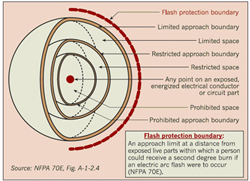Limited Approach Boundary - Arc Flash Zone Explained

Limited Approach Boundary is a critical safety concept defined in both NFPA 70E (USA) and CSA Z462 (Canada) to protect workers from arc flash and electrical shock hazards. It represents a defined distance from exposed energized conductors or circuit parts, within which only qualified personnel may enter. Understanding and enforcing this boundary is essential for compliance, injury prevention, and effective electrical safety management in industrial, commercial, and institutional power systems.
Request a Free Training Quotation
These regulations aim to minimize exposure to electrical shock and arc flash risks by establishing multiple protective boundaries, including Limited, Restricted, and Prohibited Approach Boundaries. Each has specific requirements based on voltage levels and the type of work being performed. It is vital that all qualified electrical workers understand and adhere to the company's Electrical Safety Rules.
Understanding the Limited Approach Boundary
According to NFPA 70E 2024 and CSA Z462-24, the Limited Approach Boundary is the outermost distance at which an electrical shock hazard exists. This boundary may only be crossed by a qualified or unqualified person when escorted by someone qualified and authorized. The primary intent is to prevent untrained personnel from entering a zone where they may be exposed to hazardous voltages.
For example, in a 480V system, the limited approach boundary may be set at 3.5 feet. This distance varies depending on system voltage and is outlined in standard tables provided in both NFPA 70E and CSA Z462. These tables are routinely updated based on the latest research and best practices. Understanding the Electrical Safety Requirements for Electrical Workers is essential when working within the limited approach boundary.
Who Is Responsible for Enforcing the Boundary?
Employers are legally and ethically responsible for ensuring that Limited Approach Boundaries are respected and enforced. This includes:
- Conducting risk assessments and labeling equipment appropriately.
- Providing training that qualifies workers to recognize and respond to electrical hazards.
- Establishing and maintaining clear documentation, procedures, and supervision.
In institutional settings like hospitals or universities, facility managers and safety officers must ensure that only qualified staff enter these zones. In commercial and industrial settings, it is typically the responsibility of the electrical supervisor, plant engineer, or safety coordinator.
Relation to Other Shock Protection Boundaries
The Limited Approach Boundary is part of a three-tiered structure of shock protection zones:
- Restricted Approach Boundary – Closer than the Limited Boundary, this zone requires additional protective measures, such as shock-rated PPE and insulated tools.
- Prohibited Approach Boundary – No longer formally defined in NFPA 70E (removed in the 2015 edition), but still a useful concept in risk discussions, it required the same protections as if direct contact were made.
While the Limited Approach Boundary is the outer warning zone, each subsequent boundary indicates a higher level of risk and requires more stringent protective actions.
Flash Protection Boundary (FPB) vs. Limited Approach
It is important to distinguish the Flash Protection Boundary (FPB) from the Limited Approach Boundary. While the latter deals specifically with shock hazards, the FPB relates to arc flash exposure. According to NFPA 70E, the default FPB for systems under 600V is 4 feet, but this distance can be modified through arc flash calculations, using methodologies such as IEEE 1584-2018, which replaced the 2002 edition.
These calculations consider system voltage, available fault current, and clearing time of overcurrent protective devices to determine the incident energy at a specific distance—typically 1.2 cal/cm², the threshold for a second-degree burn.
Requirements for Crossing the Limited Approach Boundary
Before crossing the Limited Approach Boundary:
- A qualified person must verify the absence of voltage using appropriate test instruments.
- If the equipment is energized, the qualified person must wear proper PPE and use insulated tools.
- The area must be clearly marked or barricaded to warn others.
Crossing the boundary without authorization or protection constitutes a serious safety violation and may result in injury, penalties, or both.
Training and Regulatory Compliance
NFPA 70E in the U.S. and CSA Z462 in Canada both mandate worker training, hazard assessments, and safe work practices. These standards are harmonized to a large degree, ensuring that workers across North America operate under consistent safety expectations.
Workers must receive retraining every three years or whenever significant changes occur in their job duties or safety procedures. Organizations must also maintain documentation demonstrating compliance with these training requirements.
Request a Free Training Quotation
The Limited Approach Boundary is more than a theoretical line—it’s a practical, enforceable part of electrical safety programs in the U.S. and Canada. It serves as an essential control measure to protect personnel from electrical shock, ensure regulatory compliance, and promote a culture of safety in industrial, commercial, and institutional environments.
By adhering to NFPA 70E and CSA Z462 guidelines, employers and workers can work together to ensure that electrical hazards are managed responsibly and minimize the risk of injury.
Arc Flash Group Training

We can present this Course to your electrical engineering and maintenance staff, on your premises, tailored to your specific equipment and requirements. We are ready to help design this program for you. Click on the link below to request a FREE quotation.
